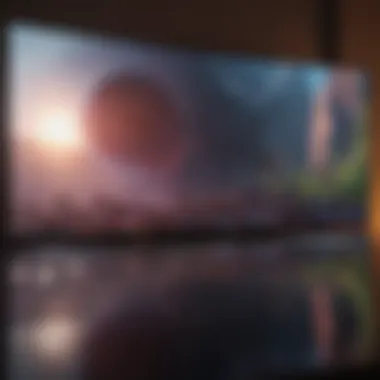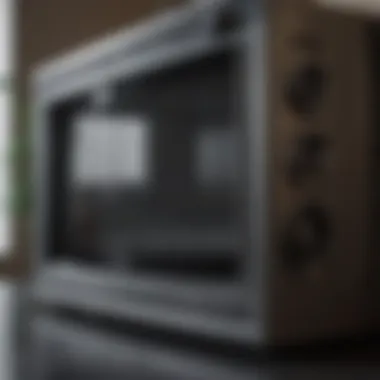Ultimate Guide to Cleaning Plasma TV Screens Safely


Intro
Cleaning a plasma TV screen is often an overlooked aspect of maintaining your home entertainment setup. Many people can spend significant time and resources selecting the perfect TV, while neglecting the care it requires. In this guide, we will examine practical methods for cleaning plasma TV screens without causing damage. Understanding the right materials and techniques is essential for optimizing the viewing experience and prolonging the life of the device.
This article will cover critical components such as the necessary tools and cleaning solutions, effective techniques to use, common pitfalls to avoid, and other tips for maintaining plasma HDTVs. By following best practices, one can enhance both the clarity of the screen and the overall lifespan of the television. This practical approach aims to provide actionable insights while steering clear of overly complex jargon.
Importance of Cleaning Plasma Screens
Cleaning not only enhances visual clarity but also contributes to the longevity of the device. Dust, fingerprints, and smudges can accumulate on the screen, potentially leading to more serious issues if neglected. Keeping the screen clean provides a better viewing experience and guards against damage that could result from using inappropriate materials or methods.
This guide emphasizes careful attention to detail with every step involved in cleaning your plasma TV screen. It is crucial to take the necessary precautions, as plasma screens are sensitive by nature. Repairing a damaged screen can be expensive and inconvenient, highlighting the need for a solid cleaning routine.
Understanding Plasma TV Screens
Understanding plasma TV screens is crucial for those who wish to preserve the quality and longevity of their devices. Unlike traditional LCD screens, plasma screens utilize a different technology that requires specific care. This section offers insights into the underlying mechanics and common issues that affect plasma displays. Knowing these factors can help in maintaining optimal performance and enhancing the viewing experience.
Mechanics of Plasma Screen Technology
Plasma screen technology works on the principle of ionized gas. Each pixel in a plasma display consists of tiny cells filled with a mixture of gases, typically neon and xenon. When an electric current passes through the cell, the gas ionizes and produces ultraviolet light. This, in turn, excites the phosphor coating on the screen, creating visible light and forming the images we see.
One of the notable features of plasma screens is their ability to produce deep blacks and vibrant colors. This characteristic is particularly appealing in cinematic environments. However, the very nature of how plasma screens operate can lead to certain vulnerabilities.
Common Issues with Plasma Screens
Despite their advantages, plasma screens are not without problems. One frequent issue is screen burn-in, where static images can leave a permanent mark on the display after prolonged exposure. This is especially concerning for viewers who may regularly watch broadcasts with constant logos.
Another issue is the potential for overheating. Plasma screens can generate significant heat during operation, which may affect their longevity over time. Dust and fingerprints also readily mar the surface, impacting image clarity.
Understanding these mechanical aspects and common issues is fundamental for plasma TV owners. It helps them to make informed decisions about cleaning and maintenance, ensuring that their viewing experience remains superb.
Materials Needed for Cleaning
Cleaning a plasma TV screen requires attention to detail and the right materials. Using suitable products ensures that the screen's surface remains intact and free from damage while enhancing the viewing experience.
Microfiber Cloths
Microfiber cloths are the gold standard for cleaning plasma TV screens. Their soft texture effectively traps dust and fingerprints without scratching the screen. Unlike traditional cotton cloths, microfiber has a structure that allows it to pick up particles efficiently. This promotes a clearer viewing surface and reduces the risk of leaving streaks. When selecting microfiber cloths, choose ones that are specifically labeled for electronics. These often lack additives that could harm sensitive surfaces. Avoid using fabric softeners when washing these cloths, as they may leave behind residues that can stick to screens. Having several microfiber cloths on hand is useful, allowing you to rotate and wash them regularly.
Cleaning Solutions
Choosing the right cleaning solution is critical in the maintenance of your plasma TV. Many conventional cleaning agents contain alcohol or ammonia, which can degrade the screen. Instead, opt for solutions made specifically for electronics or a simple mix of distilled water and white vinegar. This combination is gentle yet effective. When applying the solution, it is advisable to spray it onto the cloth instead of directly onto the screen to prevent excess moisture from seeping into edges and causing damage. It is key to read labels and ensure the solution is safe for plasma displays before use.


Alternative Cleaning Options
If you prefer not to use commercial cleaning solutions, there are effective alternative methods. One option is to use a damp cloth with just plain distilled water. This method eliminates any previous cleaning product residue that could interfere with visibility. Another method includes using baby shampoo diluted in water, which is safe and can clean smudges well. Always test any new cleaning method on a small inconspicuous area first. Avoid using over-the-counter household cleaning sprays, as their formulas are generally not tailored for delicate electronics. The right choices in cleaning materials will prolong the life and clarity of your plasma screen.
Step-by-Step Cleaning Process
Cleaning a plasma TV screen may seem overwhelming, but a clear, methodical approach makes it manageable. This section focuses on the necessity of following a detailed cleaning process. Proper steps will protect your screen from damage while ensuring optimal viewing quality. A systematic method can prevent the risk of scratches and ensure no residue is left behind.
Preparation and Safety Precautions
Beginning any cleaning task requires careful preparation and attention to safety. Ensure the plasma TV is powered off and unplugged before starting. This helps avoid electric shock and also prevents potential damage to the screen during the process. Gather the necessary materials, such as microfiber cloths and appropriate cleaning solutions. It is also wise to clear the area around the TV of clutter to have ample space and avoid accidents. Always perform a patch test with your cleaning solution on a less visible part of the screen if you are unsure about its effects.
Dusting the Surface
Dust accumulation is common on screens. Dust can also lead to streaks and marks if not addressed before cleaning. Begin by using a dry microfiber cloth to gently dust the screen. Use soft, circular motions to avoid friction. Never press too hard, as this might cause the screen to crack or become damaged. Make sure to dust the frame and stand of the TV as well, as this contributes to an overall cleaner appearance.
Applying Cleaning Solution
With the screen dust-free, it's time to apply a cleaning solution. Choose an alcohol-free cleaner formulated specifically for screens, or create a mixture using distilled water and a small amount of vinegar. Do not spray any solution directly onto the screen. Instead, lightly moisten your microfiber cloth with the cleaning solution. This method prevents excess liquid from seeping into the edges of the screen, which could lead to internal damage. Always remember that less is more in this case.
Wiping Technique Principles
When wiping the screen, adopt the right technique to ensure a clean finish. Use the microfiber cloth dampened in the solution and start from the top of the screen, working your way down in straight lines. Avoid using circular motions or applying too much pressure. Be mindful of the cloth's cleanliness; if the cloth becomes dirty from dust and debris, switch to a clean area or change the cloth entirely. Wiping should be gentle and controlled, ensuring no streaks remain once completed.
"Consistency in your cleaning method ensures a better outcome and prolonged screen life."
Following these steps will greatly enhance the care of your plasma TV screen, maintaining its pristine condition for an extended period.
Tools to Avoid
Cleaning your plasma TV screen requires delicate care. Certain tools might seem convenient but can cause irreversible damage. Understanding which items to avoid helps maintain your device's clarity and longevity. By choosing the right cleaning tools, you can prevent scratches and other unwanted marks on your screen. This section covers two major groups of tools to avoid: harsh chemicals and inappropriate cloths.
Harsh Chemicals
Using harsh chemicals on your plasma screen is a significant risk. Standard cleaning solutions often contain corrosive substances that can damage the screen's coating. Ammonia-based cleaners, for instance, can lead to discoloration and degradation over time.
If you accidentally use one of these solutions, you may find your screen exhibiting a cloudy appearance. Additionally, substances found in common household cleaners can break down the protective layers of your TV. Always check the ingredient list before applying any product to your television.
To ensure safety, opt for specially formulated plasma TV cleaners. These solutions are designed to clean without causing harm, preserving the visual quality of your screen.
Paper Towels and Rough Cloths


Many people instinctively reach for paper towels when it comes to cleaning surfaces. However, this can be detrimental to plasma screens. The texture of paper towels is abrasive and can create micro-scratches, which become more noticeable over time, leading to a hazy look.
Rough cloths, including certain types of cotton or other fibrous materials, have the same effect. Instead of these, opt for microfiber cloths. Their soft texture is gentle on screens while still effective at picking up dust and smudges.
In summary, steering clear of harsh chemicals and abrasive cloths is crucial in maintaining your plasma TV screen. Selecting appropriate cleaning materials ensures longevity and clarity, delivering optimal viewing experiences.
Maintaining Your Plasma TV Screen
Maintaining your plasma TV screen is essential for achieving optimal viewing experiences and extending the lifespan of the device. Unlike standard LCD screens, plasma displays have particular characteristics that can make them more susceptible to image quality degradation and physical damage. By developing a consistent maintenance routine, you can help preserve image clarity and prevent any potential pitfalls that can arise from neglecting care. Regular upkeep also ensures that your TV functions efficiently, thereby maintaining the value of your investment. This section delves into two crucial components of screen maintenance: establishing a regular cleaning schedule and creating an optimal viewing environment.
Regular Cleaning Schedule
Establishing a regular cleaning schedule is vital for the longevity of your plasma TV screen. Dust and smudges can accumulate over time, obscuring the display and negatively affecting picture clarity. A well-timed routine, ideally performed once a week or biweekly, provides a proactive solution to this problem.
- Frequency of Cleaning: Regular cleaning not only improves aesthetics, but it also removes dust that can settle into speakers or vents, potentially causing overheating issues. This is especially true if pets are in the home, as their hair can contribute to buildup.
- Methods to Implement: Use lightweight microfiber cloths, which are soft and avoid scratching the delicate screen surface. Making it a habit to dust the TV during your weekly cleaning can ensure that it doesn't become a monumental task.
- Utilizing Solutions Only as Needed: Be mindful about using cleaning solutions. Only use them when necessary, as excessive application can lead to streaks or residue.
Important Note: Keeping the screen in top condition supports not only visual enjoyment but also the efficient functioning of the TV set.
Optimal Viewing Environment
Creating an optimal viewing environment is another elemental part of maintenance. The setup and surroundings of your plasma TV can directly influence the visual experience and potentially the operational health of the unit.
- Lighting Conditions: Direct light can create glare on the screen and distract from viewing quality. Use curtains or blinds to manage natural light. In darker environments, ensure ou have appropriate ambient lighting to avoid eye strain.
- Temperature and Humidity: Plasma TVs operate best in an environment with stable temperatures. Excessiveheat can lead to overheating issues, whereas high humidity can introduce moisture that leads to damage over time.
- Placement of TV: Position the plasma screen properly. Avoid placing it near heat sources such as radiators or direct sunlight. The ideal height is at eye level when seated. This not only enhances comfort but also supports the long-term structural integrity of the screen.
Troubleshooting Common Issues
Many plasma TV owners encounter issues that can affect the viewing experience. This section addresses common problems, specifically streaks after cleaning and concerns related to static electricity. Understanding these issues is essential for maintaining the screen's integrity and ensuring optimal performance. With the right knowledge, users can avoid pitfalls that might diminish their TV’s functionality and aesthetic.
Streaks After Cleaning
One of the most frustrating outcomes when cleaning plasma screens is the appearance of streaks. They can arise for several reasons. First, using the wrong material can lead to this issue. Rough fabrics or materials can leave residues or scratch the surface, leading to visible streaking.
To avoid streaks:
- Use a clean, dry microfiber cloth designed specifically for electronics. These cloths trap dust and oils efficiently without leaving behind fibers.
- Always spray cleaning solutions onto the cloth, not directly onto the screen. This practice prevents oversaturation, which can result in streaks.
- Wipe gently in a circular motion, applying minimal pressure. This technique helps to lift grime without creating additional streaks.
Sometimes, residues from cleaning products might also contribute to the problem. If streaks occur despite following these steps:
- Reassess the cleaning solution you are using and ensure it is suitable for plasma screens. Products with ammonia can cause harm.
- Repeat the cleaning process with a fresh cloth, ensuring no previous residues remain.
"Preventing streaks involves both technique and the choice of materials used."


Static Electricity Concerns
Static electricity can be a concern for plasma TV screens, especially during dry conditions. A build-up of static can attract dust and other particles to the screen, leading to a dirty appearance even shortly after cleaning. Moreover, static can cause minor shocks when touching the screen, which might not damage it but can be disconcerting.
To mitigate static electricity on plasma screens:
- Use anti-static cloths when cleaning. These specialized cloths help dissipate static charge effectively.
- Humidify your environment if possible. A balanced humidity level reduces static build-up significantly. A humidity level of about 40-60% is generally ideal.
- Avoid synthetic materials when dressing or furnishing the room. Fabrics like polyester or nylon can exacerbate static issues.
Being mindful of cleaning techniques and conditions can help eliminate the concern of static interference, allowing for a cleaner and more enjoyable viewing experience.
Environmental Considerations
In the context of cleaning plasma TV screens, understanding environmental considerations is essential. This section highlights why making eco-conscious choices matters not only for the longevity of your television but also for the environment as a whole. By choosing the right products and methods, one can effectively minimize chemical waste and reduce their carbon footprint.
Sustainable practices in cleaning contribute to preserving our natural resources. When you select cleaning products that are environmentally friendly, you endorse the reduction of harmful substances entering our ecosystems. Avoiding harsh chemicals and opting for biodegradable materials creates a healthier home environment. Adopting sustainable cleaning habits can protect not only the device itself but also the broader ecological landscape.
Sustainable Cleaning Products
Sustainable cleaning products are formulated without toxic substances. They often derive their effectiveness from natural ingredients. Here are some advantages:
- Eco-Friendly Formulations: These products typically use plant-based ingredients, reducing reliance on petroleum-based chemicals.
- Non-Toxic: They safeguard your health and that of your family by minimizing exposure to harmful fumes and skin irritants.
- Biodegradable: Sustainable products break down naturally, lessening the environmental burden.
Examples include vinegar and baking soda, which serve as effective, non-toxic cleaners. You can mix a solution of equal parts water and vinegar for cleaning glass surfaces or use baking soda as a gentle abrasive.
Safe Disposal of Cleaning Materials
Disposing of cleaning materials properly is crucial. Many traditional cleaning supplies contain hazardous chemicals that can impact soil and water sources if not discarded correctly. Here are key points to consider:
- Read Labels: Check for disposal instructions on product labels. Some may need to be taken to special facilities.
- Recycle When Possible: Many containers can be recycled. Ensure they are rinsed before placing them in your recycling bin.
- Avoid Flushing: Never flush cleaning products down the toilet or drain. They can harm aquatic life and disrupt water treatment processes.
Finale
Cleaning your plasma TV screen is more than just a routine task; it is a crucial aspect of maintaining the device's functionality and longevity. Throughout this article, we have explored the necessary techniques and materials, emphasizing their significance in ensuring a clear viewing experience while protecting the screen from potential damage.
Recap of Cleaning Guidelines
To effectively clean your plasma screen, remember these guidelines:
- Preparation: Always start with a turn-off TV and a cool surface.
- Use Microfiber Cloths: They are soft enough to avoid scratches.
- Gentle Cleaning Solutions: Stick to approved solutions, avoiding harsh chemicals.
- Proper Wiping Techniques: Use a gentle circular motion while cleaning.
- Regular Maintenance: Keep a consistent cleaning schedule to prevent dust buildup.
By adhering to these steps, you will not only enhance your viewing pleasure but also significantly prolong the life of your television.
Final Thoughts on Plasma Screen Care
Caring for your plasma screen involves more than cleaning. It requires an understanding of the environment in which it operates. Ensure your TV is not exposed to direct sunlight, and maintain a dust-free area around it. Additionally, consider investing in protective screen covers when the television is not in use.
The importance of ongoing care cannot be overstated. With proper attention, your plasma TV can remain in optimal condition, offering a consistently superior viewing experience. The combination of suitable materials, effective techniques, and regular maintenance forms the backbone of successful plasma screen care. By implementing these practices, your TV will not only perform better but will also serve you well into the future.







